Blue whale blue whale ( Balaenoptera Musculus) can be described as an animal of the sea and is the baleen whale. Its maximum length is confirmed to be at 29.9 meters (98 feet) and carrying a weight of as much as 199 tons (196 long tons and 219 small tons) this is the biggest animal to exist. Baby blue whales lengthy and slim body is composed of a range of grayish-blue shades with a slight lighter underside.

Four subspecies of baby blue whales are identified The four subspecies are: B. M. Musculus within the North Atlantic and North Pacific, B. m. intermedia within the Southern Ocean, B. M. the brevicauda (the blue whale of the pygmy) within the Indian Ocean and South Pacific Ocean, B. m. indica, in the Northern Indian Ocean. There’s another population found within the waters of Chile which could be the fifth subspecies.
The majority of blue whale facts for kids whales move between habitats for feeding season during the summer in the north and south, as well as the winter breeding areas in the Tropics. It is also possible to observe permanent residences throughout the year, as well as some form of age-based or sex-based migration.
Blue whales feed on filter fish and their diet is almost entirely of Krill. They generally are solitary or in small groupings but have no clear social system aside from the mother-calf bonds. The primary frequency of blue whale vocalizations ranges between 8-25 Hz. the frequency of their vocalizations can differ based on the region or the feeding season itself, the behavior as well as the time of day. Orcas are their sole natural predators.
Blue whales were widespread in almost all oceans on Earth up to the nineteenth century. The whale was hunted until it was extinct by whalers up until it was global hunting ban by the International Whaling Commission banned all blue whale hunting in the wild in 1966. It is believed that the International Union for Conservation of Nature has classified blue whales as threatened in 2018. This endangered species act faces many man-made threats, including collisions with ships, pollution environmental noise as well as the effects of climate changes.
Description
Blue whales are small-bodied cetacean that has a large U-shaped head, thin extended flippers; and a smaller 33-centimeter (13 in) dorsal fin with a sickle shape just behind the tail. It also has an enormous tail stock located in the middle of the thin and wide flukes. The jaw’s upper part is covered with 70-395 black baleen plates. The region around the throat is lined with 60-88 grooves that allow the skin to expand when the feeding process.
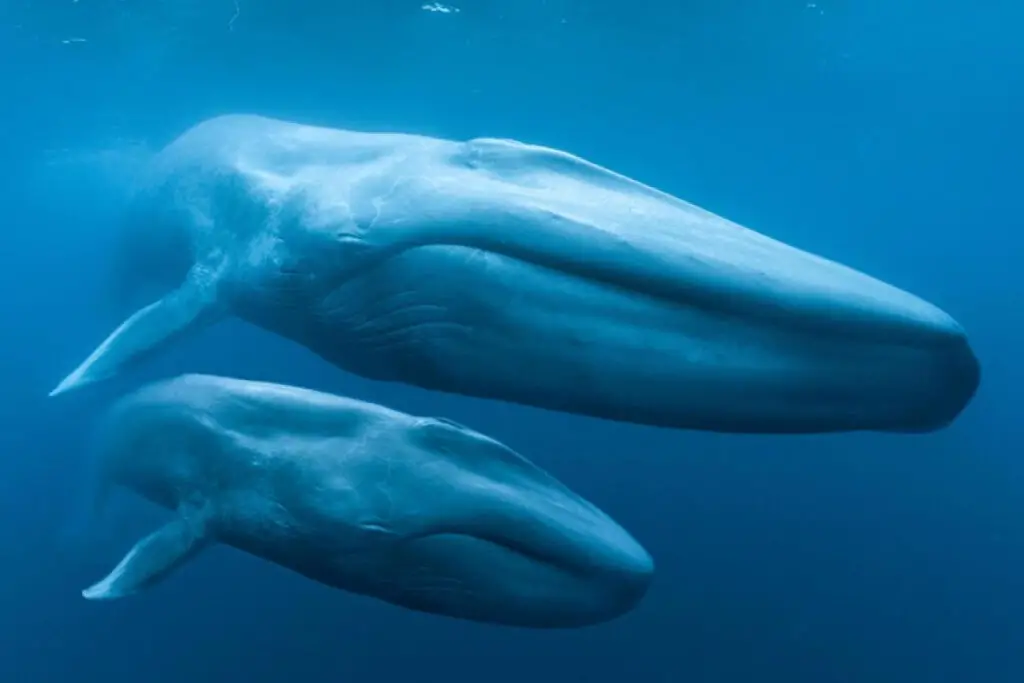
The skin has two blowholes, which allow squirting 9.1-12.2 meters (30-40 feet) into the air. Skin has a greyish blue coloration that appears to be blue in the water. The patterns of mottling near the dorsal fin’s small area are different for each individual. Underbelly areas are lighter in pigmentation and may appear yellow due to diatoms that are present in the water. This has historically gave them the name “sulphur bottom”.
Size
Blue whales are the biggest animal ever known to exist. According to the International Whaling Commission (IWC) whaling database lists 88 whales that are longer than 30 metres (98 feet) and includes one of the most massive tiny shrimplike animals that was 33 meters (108 feet) however, issues in the way measurements were made suggest that anything greater that 30.5 meters (100 feet) could be doubtful.
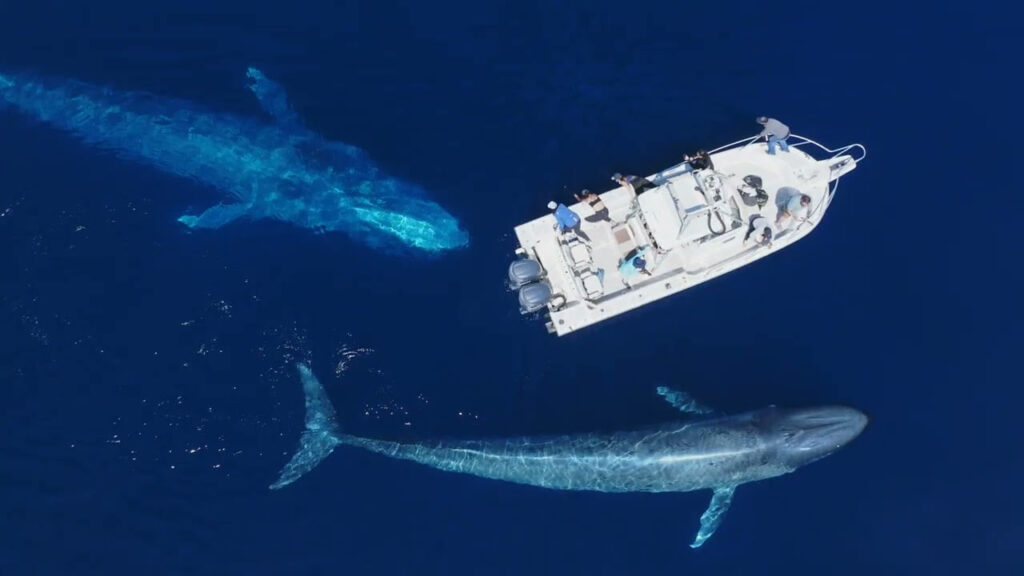
In the Discovery Committee reported lengths of largest animals were up to 31 meters (102 feet) However, the most scientifically recorded length of a blue whale measured 30 meters (98 feet) from the rostrum’s tip up to the tail from rostrum tip to tail. Female blue weigh more than male blue whales. The hydrodynamic model suggests that the blue whale cannot surpass 108 feet (33 meters) due to metabolic and energy restrictions.
The length average of female blue who are sexually mature can be 22.0 meters (72.1 feet) in the case of Eastern North Pacific blue whales 24, meters (79 feet) for the western and central North Pacific blue whales, 21-24 meters (68-78 feet) in the case of North Atlantic blue whales, 25.4-26.3 meters (83.4-86.3 inches) in the case of Antarctic blue whales. 23.5 meters (77.1 feet) in the case of Chilean blue whales in addition to 21.3 meters (69.9 feet) for the blue whale calf and whales that are pygmy.
Blue whale calves in within the Northern Hemisphere, males weigh on average 100 metric tonnes (220,000 pounds) and females weigh 112 tonnes (247,000 pounds). Eastern North Pacific blue whale males weigh an average of 88.5 tonnes (195,000 pounds) while females average 100 tonnes (220,000 lbs).
Antarctic blue underwater males have an average of 112 tonnes (247,000 pounds) and females weigh 130 tonnes (290,000 pounds). Males of the Pygmy blue whale average 83.5 tonnes (184,000 pounds) up to 99 tonnes (218,000 pounds). The mass of the heart in the sustained North Atlantic blue whale was 180 kilograms (400 pounds) which is the highest known weight for any creature.
The blue whale that holds the record was estimated at 173 tons (190 short tons) and estimates range from between 199 and 199 tons (220 shorter tons).
Life span
Blue whales are believed to live between 80 and 90 years or longer. Scientists study the blue whale’s earwax and ear plug to calculate the age of its ear. Every year, a thin and thick layer of wax gets placed on top of the fasting eating and movement. Every set thus is an indication of the time. The oldest blue whale discovered with this method was aged 110 years.

The average age of the pygmy blue whale that can be determined by this method is 73 years. Furthermore female blue whales form marks or corpora albicantia over their ovaries each time they are ovulating. When a female blue pygmy whale the corpus albicans gets created approximately every 2.6 years.
Behavior
The blue whale typically a single largest animal, however it can be seen in groups. If the productivity is sufficient the blue whales may be observed in large groups of more than 50 people. Blue whales in adulthood can travel for long distances that take them to their summer feeding sites to the poles, before going to winter habitats in the equatorial oceans.
They appear to use memories to identify the most suitable food sources. There are evidences of other options, like all-year-round residence, limited (where just a handful of individuals travel) or sex/age-based migration. Whales have been found eating in breeding areas. Blue whales is between 5 and 30 kilometers per hour (3.1-18.6 miles per hour).
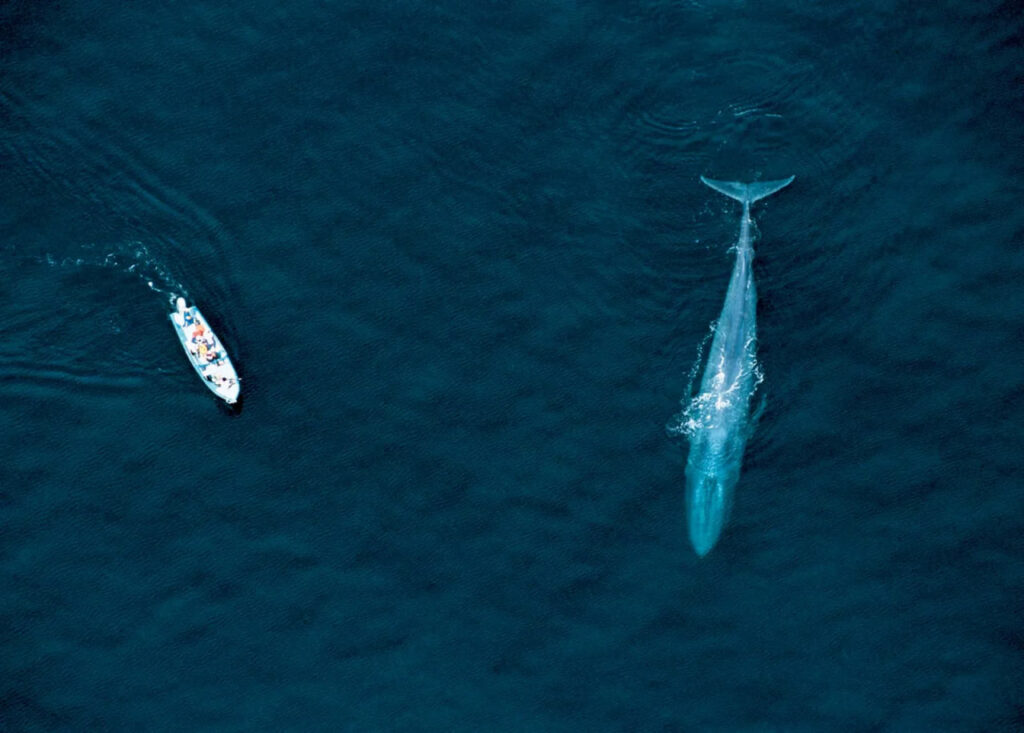
The deepest dive recorded by blue whales tagged measured 315 m (1,033 feet). Their aerobic dive time was guessed to be 31.2 minutes. However the longest dive that was recorded to be 15.2 minutes.
The deepest dive that was confirmed by the blue whales of the pygmy era was 510 metres (1,660 feet). Blue whales’ heart rates could drop as low as two beats per minute (bpm) in deep water however, upon surface, it could rise up to 37 beats per minute that is near its maximum heart rate.
Diet and feeding
Blue whales’ diet is nearly exclusively of the krill. Blue whales consume krill via lunge feeding. They can swim toward the krill at high speed when they open their mouths to up to 80 degrees they can eat whales 220 metric tonnes (220 long tons and 244 small tonnes) in water all at the same moment.
They force the water out via their baleen plates by pressure through the mouth pouch, throat and tongue. Then they consume the remainder of the krill. Blue whales are known to be doing 180deg roll-feeds during lunge feeding which could allow them to look around the field of prey to find those with the largest patches.
When they are pursuing patches of krill, blue whales boost their calorie consumption by increasing the number of lunges they take while focusing on the most dense patches. It provides the energy they require for their day-to-day tasks while also storing the energy needed for migration and reproduction.
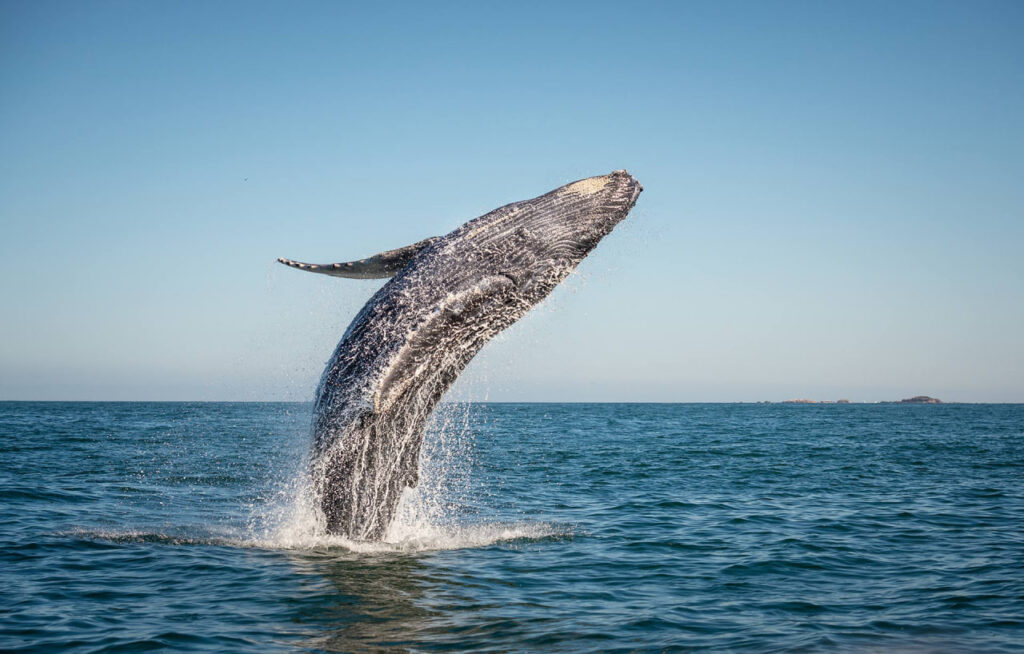
Blue whales need to consume the krill at a rate of more than 100 kilo/m3 to keep the costs of feeding on the lunge. They can consume between 34,776 and 1,912,680 Kilojou (8,312-457,141 kcal) by eating a mouthful Krill. This can give an additional 240-fold amount of energy than the amount consumed in one single lunge. According to estimates, the average blue whale will consume a total of 1,120 +-359 kilograms (2,469 791 pounds) of krill every day.
Blue whales seem to stay clear of direct competition with baleen whales. Different species of whales have various feeding times and spaces and also various predator species. Within the Southern Ocean, baleen whales seem to consume massive amount of Antarctic Krill of various dimensions. This could help reduce their competition.
Reproduction and birth female blue whales
Blue whales usually achieve sexual maturity around 8-10 years of age. Within the Northern Hemisphere, the length that they attain maturation is between 21 and 23 meters (69-75 feet) for females, and 20-21 meters (66-69 feet) to males.
In the warmer waters of Southern Hemisphere, the length of maturation ranges from 23-24 meters (75-79 feet) as well as 22 metres (72 feet) for males and females in the respective cases. Male blue whales pygmy have an average of 18.7 meters (61.4 feet) when they reach maturity at sexual maturation. Female blue whales that pygmy are 21.0-21.7 meters (68.9-71.2 feet) in length.
They are approximately 10 years old when they reach the time of sexual maturity. It is unclear what the mating habits, as well as the breeding or birthing zones. Blue whales seem to be multigynous with males fighting against females. Male blue whales typically follows a female, and may battle potential competitors. The blue whales are mate-in-the-fall until winter.
The average pregnant female consumes 4 percent of their body weight every day that is about 60 percent of the total weight during summer foraging period. Gestation can last from colder months to 10 to 12 months. Calves are 7 to 6-7 meters (20-23 feet) in length and weighing around 2-3 meters (2.0-3.0 large tons, 2.2-3.3 short tonnes) when they are born.
The estimates suggest that since calves need between 2-4 kg (4.4-8.8 pounds) milk for each kilogram of weight gain Blue whales are likely to make 220 kilograms (490 pounds) of milk each day (ranging between 110 and 320 kilograms (240 to 710 lbs) of milk daily). The very first video showing the blue whale calves believed that it was nursing recorded by a researcher in New Zealand in 2016.
The calves could be weaned once they are six months to an average length of 16 meters (53 feet). The average weight gain is 37,500 lbs (17,000 kg) throughout the weaning phase. Interbirths last between two and three years. They average 2.6 years for blue pygmy whales.
Vocalizations
Blue whales make one of the most loud and most low-frequency vocalizations within the largest animal kingdom. Furthermore, their ears are tuned to hear low-frequency sound. The basic frequency of blue whale vocalizations is 8-25 Hz. Blue whale song patterns vary across endangered species.
Vocalizations made by those from the Eastern North Pacific population have been extensively examined. The population has pulsed calls (“A”) as well as tone calls (“B”) as well as with upswept tones preceding type B-calls (“C”) and distinct calls that are downswept (“D”). The B and A calls typically occur in sequential sequences, and are sung exclusively by males. This suggests the possibility of a reproduction function. D calls can perform multiple roles. They can be generated by males and females alike during meals and social interaction. Males also produce them when they compete with their mates.
Blue whales that have been recorded from Sri Lanka have a three-unit phrase. First, there is an 19.8 up to 43.5 Hz pulsive signal that is typically 17.9 + 5.2 seconds in length.
The second is a 55.9 up to 72.4 frequency FM upsweep, which has 13.8 + 1.1 seconds in length. The last unit is 28.5 + 1.6 seconds and has a tone of 104.7 to 104.7 Hz. Blue whale calls recorded off Madagascar is a phrase that has two units composed of 5-7 different pulses that have a central time of 35.1 + 0.7 000 Hz that lasts 4.4 + 0.5 seconds before with a 35 + 0 unison tone, which is 10.9 + 1.1 seconds in length.
The Southern Ocean, where blue whales live, make 18-second vocals that begin with a long, 9 second Hz tone. Then, one second of downsweep, which is then lowered to 19 Hz then a further downsweep up to 18 Hz. Another vocalization is 1-4 seconds long frequency-modulated call that have a frequency between the range of 80 to 38 Hz.
There is evidence to suggest that some blue whale songs have diminished in their tonal volume. Blue whales’ vocalization throughout the Eastern North Pacific decreased in the frequency of their tones by 31% between beginning of the 1960s through in the mid 21st century.
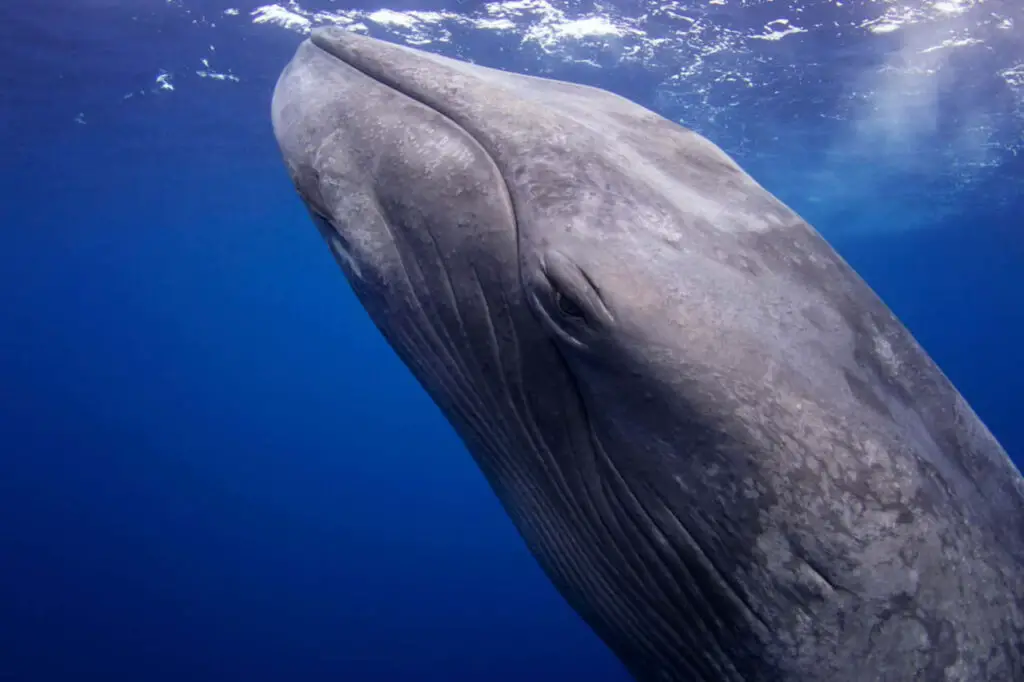
The frequency of both adult blue whales and pygmy whales within the Antarctic is down by just a fraction of a hertz per year since 2002. The possibility is that the blue whale population is recovering from whaling, they will experience an increase in the pressure of sexual selection (i.e. the lower number of whales indicates greater size).
10 Interesting blue whale facts for kids
- At the time of maturity an 180-ton blue whale could weigh more than 24 elephants at the age of adulthood. The tongue alone could weigh the same as the weight of an elephant. (elephants may weigh as much as 15,000 pounds!)
- Blue whales are known to consume an estimated 8,000 pounds, or four tons of krill each day.
- The baby blue whale could take up to 150 gallons milk daily during the first year following birth.
- In search of food Blue whales have been recorded as diving more than 300 feet. It can hold its breath for longer than 35 mins (most dives are 10 to 20 minutes or shorter).
- Blue whales aren’t blue, in the sense of hue, but it’s a grayish-blue hue which appears blue when the whale has dived under the sea.
- If they are scared If they are scared or threatened, marine mammals may achieve speeds of over 30 mph during brief bursts, but they can achieve an average speed of between 3 12- 12 mph, in many situations.
- The most natural predator of the blue whale is a group of killer whales hungry for food. These attacks, however, are very rare and most often involving young youngsters and/or small blue whales rather than larger adults.
- Due to their massive size, blue whales usually wander on their own or in small groups. Their size is huge, which provides the marine mammals with an excellent defense since their large body blocks predators from attacking the blue whales.
- When it is in the middle of a long migration that the blue whale undertakes marine mammals, it is often observed to be fasting for at least 4 months, and eat excess body fat stored up during feeding time.
- Blue whales be in contact with each other from 1000 miles apart due to their caustic vocals and exceptional hearing.
FAQ
What are 5 interesting facts about blue whales?
Think about these blue whale facts:.. The Blue Whale can reach 100 feet in length. … The elephant is 30 pounds. … There’s a tremendous excitement. … It also has a big tongue. … It’s the biggest baby blue whale they have. … This can be described as unusually loud. … Krill is consumed by them frequently. … The speeds are quite high.
Why is blue whale called blue?
Muscles are located in massive body is under water, and the pale skin reflect the blue whale facts light that is absorbed by your body e.g. sunlight. Blood vessels’ colour This film is influenced of water and light. Blue whales were never in the same light as its colour.
What does blue whale eat?
They mainly consume krill eating huge, large quantities of seawater in Baleen. The smallest person in the world could eat six tonnes of krill every day.


